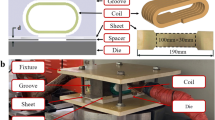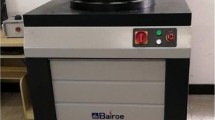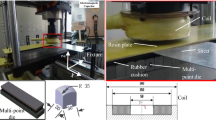Abstract
Electromagnetic forming is a high-speed forming process, and it can generate high contact force between the sheet metal and die. Therefore, the effects of die counter-impact on aluminum alloy sheet during electromagnetic forming were numerically and experimentally investigated. Firstly, the numerical simulations of electromagnetic free forming and electromagnetic die forming were performed with the Gurson-Tvergaard-Needleman damage model. When the aluminum alloy sheet impacted the die, an unignorable normal stress occurred along the thickness direction. The void volume fraction was reduced due to the negative stress triaxiality, and the residual stress became smaller. Secondly, the effect of die counter-impact on the pre-deformed aluminum alloy sheet was numerically inspected for quasi-static and dynamic hybrid electromagnetic forming. Compared with the electromagnetic die forming of aluminum alloy sheet without pre-deformation, the void volume fraction and residual stress reductions were more significant for the pre-deformed aluminum alloy sheet. Finally, the aluminum alloy sheets after different electromagnetic forming experiments were compared by optical microscope and Vickers hardness. The results show that the damage suppression and hardness enhancement are attributed to the effect of die counter-impact, especially for the hybrid quasi-static and dynamic forming processes.















Similar content being viewed by others
Data availability
The datasets used or analyzed during the current work are available from the corresponding author on reasonable request.
References
Li J, Li L, Wan M, Yu H, Liu L (2018) Innovation applications of electromagnetic forming and its fundamental problems. Procedia Manuf 15:14–30
Tekkaya AE, Allwood JM, Bariani PF, Bruschi S, Cao J, Gramlich S, Groche P, Hirt G, Ishikawa T, Löbbe C, Lueg-Althoff J, Merklein M, Misiolek WZ, Pietrzyk M, Shivpuri R, Yanagimoto J (2015) Metal forming beyond shaping: predicting and setting product properties. CIRP Ann Manuf Technol 64:629–653
Tekkaya AE, Khalifa NB, Hering O, Meya R, Myslicki S, Walther F (2017) Forming-induced damage and its effects on product properties. CIRP Ann 66(1):281–284
Psyk V, Risch D, Kinsey BL, Tekkaya AE, Kleiner M (2011) Electromagnetic forming—a review. J Mater Process Technol 211(5):787–829
Cui X, Li J, Mo J, Fang J, Zhou B, Xiao X, Feng F (2016) Incremental electromagnetic-assisted stamping (IEMAS) with radial magnetic pressure: a novel deep drawing method for forming aluminum alloy sheets. J Mater Process Technol 233:79–88
Vohnout VJ (1998) A hybrid quasi-static/dynamic process for forming large sheet metal parts from aluminum alloys. The Ohio State University
Shang J, Daehn G (2011) Electromagnetically assisted sheet metal stamping. J Mater Process Technol 211(5):868–874
Imbert JM, Winkler SL, Worswick MJ, Oliveira DA, Golovashchenko S (2005) The effect of tool–sheet interaction on damage evolution in electromagnetic forming of aluminum alloy sheet. J Eng Mater Technol 127(1):145–153
Golovashchenko SF (2007) Material formability and coil design in electromagnetic forming. J Mater Eng Perform 16(3):314–320
Iriondo E, Gutiérrez MA, González B, Alcaraz JL, Daehn GS (2011) Electromagnetic impulse calibration of high strength sheet metal structures. J Mater Process Technol 211(5):909–915
Kim J, Noh HG, Song WJ, Kang BS (2014) Comparative numerical analysis of sheet formed into a V-shaped die using conventional and electromagnetic forming processes. Adv Mech Eng 6:240789
Su H, Huang L, Li J, Ma F, Huang P, Feng F (2018) Two-step electromagnetic forming: a new forming approach to local features of large-size sheet metal parts. Int J Mach Tools Manuf 124:99–116
Liu W, Zou X, Huang S, Lei Y (2019) Electromagnetic-assisted calibration for surface part of aluminum alloy with a dedicated uniform pressure coil. Int J Adv Manuf Technol 100(1-4):721–727
Feng F, Li J, Zhang Y, Huang L, Su H, Cao S, Shao G, Chen R (2020) Microstructure evolution of 5052 aluminum sheet in electromagnetic high-speed impact. Metals 10(5):564
Zeng X, Meng Z, Liu W, Huang S, Zhou S, Lin Y (2020) Deformation behaviour and damage evolution of aluminium alloy sheet in electromagnetic forming with uniform pressure actuator. Int J Adv Manuf Technol 109(3):745–754
Feng F, Li J, Huang L, Su H, Li H, Zhang Y, Cao S (2021) Formability enhancement of 5052 aluminium alloy sheet in electromagnetic impaction forming. Int J Adv Manuf Technol 112(9):2639–2655
Kamal M, Daehn GS (2007) A uniform pressure electromagnetic actuator for forming flat sheets
Needleman A, Tvergaard V (1984) An analysis of ductile rupture in notched bars. J Mech Physf Solids 32(6):461–490
Noh HG, Lee K, Kang BS, Kim J (2016) Inverse parameter estimation of the Cowper-Symonds material model for electromagnetic free bulge forming. Int J Precis Eng Manuf 17(11):1483–1492
Funding
This work was supported by the National Natural Science Foundation of China (Grant No. 52005374) and Natural Science Foundation of Hubei Province (Grant No. 2019CFB196).
Author information
Authors and Affiliations
Contributions
Zhenghua Meng and Shangyu Huang conceived and designed the work. Yangzhe Lin and Xiaoyong Zeng carried out the experiments and provided figures and tables. Yangzhe Lin and Wei Liu analyzed the data and edited the manuscript. Wei Liu reviewed and improved the manuscript.
Corresponding authors
Ethics declarations
Ethics approval
This work complies with the ethical standards set out by Springer.
Consent to participate
Not applicable.
Consent to publish
Not applicable.
Competing interests
The authors declare no competing interests.
Additional information
Publisher’s note
Springer Nature remains neutral with regard to jurisdictional claims in published maps and institutional affiliations.
Rights and permissions
About this article
Cite this article
Lin, Y., Liu, W., Meng, Z. et al. The effects of die counter-impact on aluminum alloy sheet during electromagnetic forming. Int J Adv Manuf Technol 116, 3593–3601 (2021). https://doi.org/10.1007/s00170-021-07704-0
Received:
Accepted:
Published:
Issue Date:
DOI: https://doi.org/10.1007/s00170-021-07704-0




